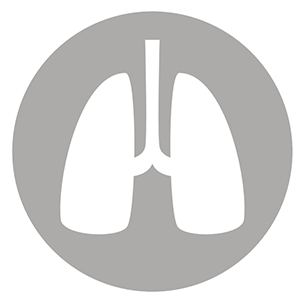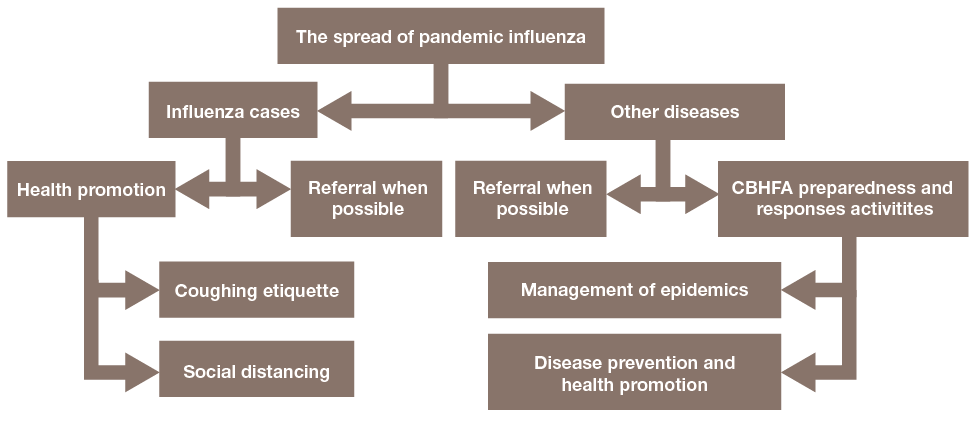Group 4. Acute respiratory infections
 |
Disease tools: 16. Acute respiratory infections |
| Acute respiratory infections |
|---|
| occur when germs affect the respiratory system of a person and cause an infection. |
Acute respiratory infections are diseases that affect the respiratory tract. They can be mild, causing only some pain or coughing, but can also be very severe, causing fever, difficulty in breathing, and coughing. Very serious cases may lead to death if they are not treated properly or quickly. These diseases mainly cause epidemics when living conditions (overcrowded houses and tents) allow them to spread easily.
Some acute respiratory infections, such as pertussis (whooping cough), can be prevented by vaccination. These have been described in a previous section.
How are these diseases transmitted?
Acute respiratory infections are transmitted by droplets released into the air when a sick person coughs or sneezes. The droplets contain germs and can be breathed in by other people, causing them to become sick too.
What symptoms do they cause?
Acute respiratory infections can be mild or very severe and can result in death if they are not treated. Usually, they cause fever with a wet (with sputum) or dry cough. This can make it very difficult for those infected (usually children) to breathe. Children with respiratory infections appear exhausted and pale.
How do we prevent the spread of these diseases?
The spread of acute respiratory infections can be prevented by some simple actions:
- Adopt safe habits, including coughing etiquette and regular handwashing. This will reduce the spread of respiratory infections, can prevent epidemics, and will reduce their impact if they occur.
- Improve shelters and density of occupation; generally reduce overcrowding in the community.
- Identify people in the community who are sick with respiratory infections before they spread the infection to others.
- Take prompt steps to treat and refer children and vulnerable people who have a cough or difficulty breathing.
- Take steps to improve the amount and quality of food available to the community.
- Tell members of the community about respiratory diseases and explain how they can prevent and manage them.
How to deal with cases of these diseases?
Acute respiratory infections are sometimes hard to treat, and sick individuals will need to be cared for by health professionals. The main role of volunteers is to identify cases and refer them to health facilities. In addition, volunteers can help children who have acute respiratory infections by promoting recommended dietary practices, including nutritious foods and appropriate fluid intake (water, juices and soups).
How to detect an epidemic?
An epidemic of acute respiratory infections is suspected when many people (especially if they live in crowded conditions) have fever, a cough and difficulty breathing.
| The epidemic |
|---|
|
Who? Where? When? Why? |
How to deal with an epidemic?
If an epidemic of acute respiratory infections occurs, the following actions should be taken:
- Build trust with members of the community.
- Involve members of the community in efforts to control the epidemic.
- Familiarize yourself with the culture of the community.
- Take steps to identify people who are sick and refer them to health facilities.
- Improve shelters. Increase airflow where possible, and reduce overcrowding.
- Improve nutrition; provide children with good food.
- Obtain prompt treatment of sick people in clinics and health facilities.
What can volunteers do?
During an epidemic of this group of diseases, volunteers can do very useful work promoting health and can also identify cases and refer them to appropriate health facilities for treatment. In particular, you should:
- Monitor the spread of the epidemic by working with the community to carry out house-to-house visits to assess living conditions and detect people who have fever, a cough and difficulty breathing.
- Refer people with acute respiratory infections to health centres or hospitals.
- Encourage people who have a respiratory infection, especially children, to have plenty of healthy food and liquids.
- Improve conditions in shelters. If possible, increase the flow of fresh air and reduce overcrowding.
- Give psychosocial support to sick people and their families.
- Promote sound health practices:
- Encourage people to adopt good habits, such as handwashing, and cover their mouth and nose when they cough or sneeze.
- Explain the symptoms of respiratory infections.
- Explain to parents and carers how to manage sick children.
- Advise parents and carers to take sick children to a health facility.
- Teach good nutrition.
- Encourage people to give fluids to sick children.
| What is a pandemic? |
|---|
| A pandemic is an epidemic that spreads to many countries in a short period of time and affects a high proportion of the population. It can be caused by any disease that spreads easily and is new to the population. In the past, there have been pandemics of influenza, the plague and cholera. |
Acute respiratory infections and pandemics
At the moment, there is no influenza pandemic. The germ that will cause an influenza pandemic does not yet exist. It will come to exist when the germ that causes influenza changes (mutates) in certain ways.
Some influenza germs start in animals and mutate to affect humans. Birds, pigs and camels have all been sources of influenza or respiratory infections that have had the potential to become pandemics. If a germ that affects animals can mutate to infect humans, it can mutate again to become more easily transmissible from one person to another. Then a rare serious disease becomes a serious disease that can spread very rapidly to very large numbers of people across the world, because people have no immunity to the new germ. This is what we call a pandemic.
If a pandemic occurs, millions of people could fall sick and many could die. In addition, a pandemic would affect all aspects of normal life. For example, hospitals would be overwhelmed with patients, travel services would come to a halt, schools and other institutions would close. In such a situation, local resources (such as volunteers) will be vital to help people overcome the effects of the disease, care for patients, manage the pandemic, and, when it is over, help people to return to normal life.
Influenza pandemics have occurred in the past. They include the “Spanish flu” of 1918-1919, the “Asian flu” of 1957-1958, the “Hong Kong flu” of 1968- 1969, and most recently “swine flu”, which started in 2009 but was not transmitted directly from pigs or swine.
How are avian and pandemic influenza transmitted?
Avian influenza passes between birds through their fluids, feathers and faeces. It can spread in the same way to humans and cause them to become ill. It can also potentially spread to humans from the meat or eggs of sick chickens or other infected (live and dead) birds that have not been cooked thoroughly. Note that classical human influenza spreads by respiratory rather than faecal-oral means.
Pandemic influenza, like the respiratory infections we talked about earlier in the chapter, is transmitted by droplets released into the air by coughing or sneezing. The droplets carry germs and can be breathed in by others, causing them also to become sick. It is important to know that the droplets emitted by coughing or sneezing do not go very far: they only travel about 1.5 metres. This means that if we are further than 1.5 metres from a sick person, we are very unlikely to catch the disease from them. We should always remember this when dealing with pandemic influenza, because keeping a safe distance from sick people (called “social distancing”) is the most effective prevention measure. It is still important to maintain hand hygiene, because those who are sick may sneeze into their hands and transmit germs when they turn doorknobs, hold bus handrails, etc.
What symptoms do avian and pandemic influenza cause?
Both avian and pandemic influenza can cause severe infections in humans. The symptoms are very similar to those associated with regular acute respiratory infections, and include: sudden illness, fever, a cough, shortness of breath and, in some cases, chills, a runny nose, sore throat, tiredness, and upset stomach or loss of appetite. These symptoms may be very severe if those affected have had no previous exposure and are meeting the virus for the first time.
How to prevent the spread of avian and pandemic influenza?
We can prevent the spread of avian influenza and other illnesses caused by animals by detecting the disease early in the animals and reporting sick animals. Veterinary authorities should then quarantine potentially infected flocks; if they test positive, they should be humanely killed. It is important to educate communities about having contact with infected poultry, particularly the hazards of preparing and consuming sick birds (or in some cases making blood pudding). Cooking meat and eggs thoroughly sharply reduces the chances of infection.
How to deal with cases of pandemic influenza?
The best ways to deal with cases of pandemic influenza are to isolate sick people, to practice social distancing in the community, and to refer people with symptoms rapidly to health facilities. When a pandemic occurs, many people who have different diseases will not receive medical attention because hospitals and clinics will be overwhelmed by influenza patients. This means that those diseases will need to be dealt with by other means. The diagram below shows how to manage influenza patients in the community and how to help people with other illness who may not be able to obtain treatment because hospitals and clinics are overwhelmed.
Figure 15. Spread of pandemic influenza

How to deal with an influenza pandemic?
The best way to deal with an epidemic or a pandemic is to be well prepared. The International Federation of Red Cross and Red Crescent Societies is part of a worldwide effort to prepare for an influenza pandemic, alongside National Societies, governments and many other national and international partners.
When a pandemic occurs, volunteers can do a number of things to help. In particular:
- Avoid getting ill yourself. Adhere strictly to social distancing, handwashing, and other recommended hygiene practices. Use personal protection equipment when you are in a clinical setting.
- Reduce the spread of the disease by promoting recommended health practices, such as social distancing and hygienic habits.
- Help maintain public infrastructure. When a pandemic occurs, many services (including water and sanitation, schools, health facilities, transport systems) will be disrupted. Work will need to be done to keep such services in operation.
- Take care of people suffering from other diseases. While health facilities are coping with patients who have influenza, they may not be able to treat people who have other diseases. Most of them will have to be cared for by other health services or the community.
What can volunteers do?
Volunteers will be one of the cornerstones of National Society efforts to deal with an influenza pandemic. You will be asked to carry out the tasks listed above.
Participate
Discuss in your group a possible epidemic of an acute respiratory infection in your community. Look at the disease tools for acute respiratory infections and select the action and message tools for each. Discuss with your facilitator the similarities and differences between the tools for each disease in this category.
It is important to recognize that the most effective ways to end epidemics in this category are promotion of good coughing etiquette, handwashing, social distancing, vaccination of children under five, and early referral. Discuss the challenges of changing behaviour in your community.
Discuss the difference between epidemics and pandemics.
Compare volunteer roles in epidemics with volunteer roles in pandemics.